Fantomah
First Appearance: Jungle Comics #2 (Feb. 1940)
Created by Fletcher Hanks (a.k.a. Barclay Flagg)
Publisher: Fiction House
.
The Woman in Red (Peggy Allen)
First Appearance: Thrilling Comics #2 (Mar. 1940)
Created by Richard Hughes and George Mandel
Publisher: Nedor Comics
.
Catwoman (Selena Kyle)
First Appearance: Batman #1 (Spring 1940)
Created by Bob Kane and Bill Finger
Publisher: Detective Comics, Inc. (DC)
.
Lady Luck (Brenda Banks)
First Appearance: The Spirit (syndicated – June 2, 1940)
Created by Will Eisner and Chuck Mazoujian
Publisher: Register and Tribune Syndicate
.
Invisible Scarlet O’Neil
First Appearance: Invisible Scarlet O’Neil (syndicated – June 3, 1940)
Created by Russell Stamm
Publisher: The Chicago Times
.
Black Widow (Claire Voyant)
First Appearance: Mystic Comics #4 (Aug. 1940)
Created by George Kapitan and Harry Sahle
Publisher: Timely Comics (Marvel)
.
Red Tornado (Abigail Mathilda “Ma” Hunkel)
First Appearance (as Red Tornado): All-American Comics #20 (Nov. 1940)
Created by Sheldon Mayer
Publisher: All-American Publications (DC)
.
Miss Fury (Marla Drake)
First Appearance: Black Fury (syndicated – April 6, 1941)
Created by Tarpe Mills
Publisher: Bell Syndicate, reprinted by Timely Comics (Marvel)
.
Bulletgirl (Susan Kent)
First Appearance (as Bulletgirl): Master Comics #13 (April 1941)
Created by Bill Parker and John Smalle
Publisher: Fawcett Comics
.
Hawkgirl (Shiera Sanders)
First Appearance (as Hawkgirl): All Star Comics #5 (July 1941)
Created by Gardner Fox and Dennis Neville
Publisher: All-American Publications (DC)
.
Black Cat (Linda Turner)
First Appearance: Pocket Comics #1 (Aug. 1941)
First Solo Title: Black Cat Comics #1 (Jun. 1946)
Created by Alfred Harvey with art by Al Gabrielle
Publisher: Harvey Comics
.
Phantom Lady (Sandra Knight)
First Appearance: Police Comics #1 (Aug. 1941)
First Solo Title: Phantom Lady #13 (Aug. 1947)
Created by Eisner-Iger Studio, re-designed by Matt Baker
Publisher: Quality Comics; Fox Features Syndicate
.
Miss Victory (Joan Wayne)
First Appearance: Captain Fearless #1 (Aug. 1941)
Created by Charles Quinlan and unknown writer
Publisher: Helnit Publishing Co.
.
Spider Queen (Shannon Kane)
First Appearance: The Eagle #2 (Sep. 1941)
Created by Louis and Arturo Cazeneuve
Publisher: Fox Features Syndicate
.
Wonder Woman (Diana Prince)
First Appearance: All Star Comics #8 (Dec. 1941)
First Solo Title: Sensation Comics #1 (Jan. 1942)
Second Solo Title: Wonder Woman #1 (Summer 1942)
Created by William Marston with art by Harry Peter
Publisher: All-American Publications (DC)
.
Lady Satan
First Appearance: Dynamic Comics #2 (Dec. 1941)
Created by unknown
Publisher: Harry “A” Chesler
.
Spider Widow (Dianne Grayton)
First Appearance: Feature Comics #57 (Jun. 1942)
Created by Frank Borth
Publisher: Quality Comics
.
Liberty Belle (Libby Lawrence)
First Appearance: Boy Commandos #1 (Winter 1942)
Created by Don Cameron and Chuck Winter
Publisher: Detective Comics, Inc. (DC)
.
Mary Marvel (Mary Batson)
First Appearance: Captain Marvel Adventures #18 (Dec. 1942)
Created by Otto Binder and Marc Swayze
Publisher: Fawcett Comics
.
Miss America (Madeline Joyce Frank)
First Appearance: Marvel Mystery Comics #49 (Nov. 1943)
First Solo Title: Miss America Comics #1 (early 1944)
Created by Otto Binder and Al Gabrielle
Publisher: Timely Comics (Marvel)
.
Blonde Phantom (Louise Grant)
First Appearance: All-Select Comics #11 (Sep. 1946)
First Solo Title: Blonde Phantom #12 (Jan. 1947)
Created by Stan Lee and Syd Shores
Publisher: Timely Comics (Marvel)
.
Miss Masque (Diana Adams)
First Appearance: Exciting Comics #51 (Sep. 1946)
Created by unknown
Publisher: Nedor Comics
.
Black Canary (Dinah Drake-Lance)
First Appearance: Flash Comics #86 (Aug. 1947)
Created by Robert Kanigher and Carmine Infantino
Publisher: National Comics (DC)
.
Moon Girl (Claire Lune)
First Appearance: Moon Girl and the Prince #1 (Fall 1947)
Created by Max Gaines, Gardner Fox, and Sheldon Moldoff
Publisher: EC Comics
.
Golden Girl (Betsy Ross)
First Appearance (as Golden Girl): Captain America Comics #66 (Dec. 1947)
Created by Joe Simon and Jack Kirby
Publisher: Timely Comics (Marvel)
.
Merry, The Girl with 1,000 Gimmicks (Merry Pemberton)
First Appearance: Star Spangled Comics #81 (Jun. 1948)
Created by Otto Binder and Win Mortimer
Publisher: National Comics (DC)
.
Bat-Woman (Kathy Kane)
First Appearance: Detective Comics #233 (Jul. 1956)
Created by Edmond Hamilton, Sheldon Moldoff, and Stan Kaye
Publisher: National Comics (DC)
.
Supergirl (Kara Zor-El, Linda Danvers)
First Appearance: Action Comics #252 (May 1959)
Created by Otto Binder and Al Plastino
Publisher: National Comics (DC)
.
Bat-Girl (Betty Kane)
First Appearance: Batman #139 (Apr. 1961)
Created by Bill Finger and Sheldon Moldoff
Publisher: National Comics (DC)

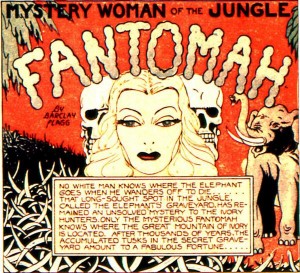
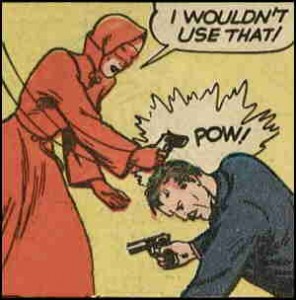
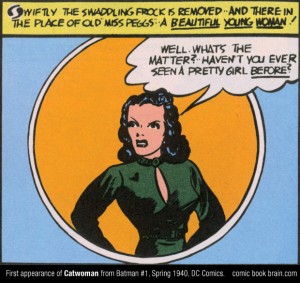
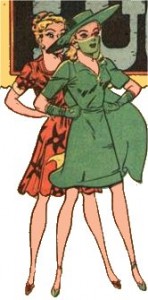
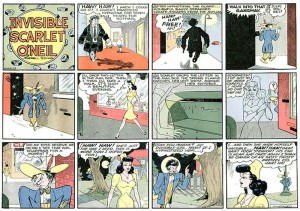
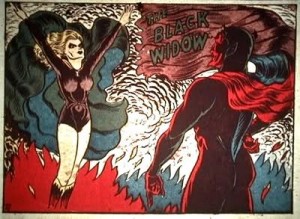
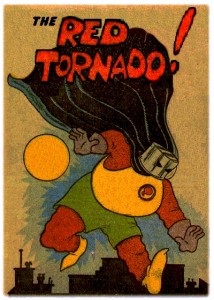
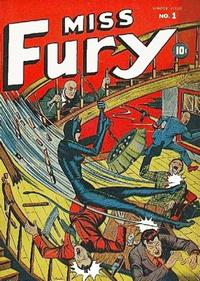
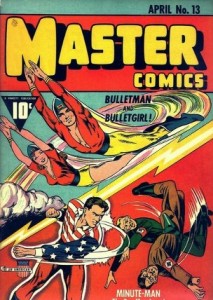
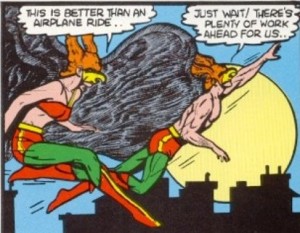

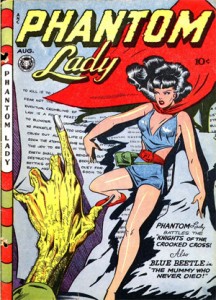
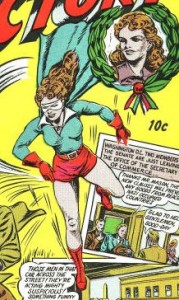
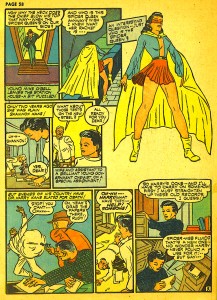
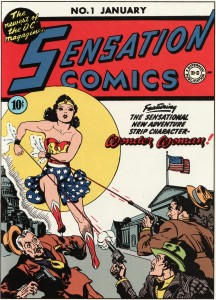
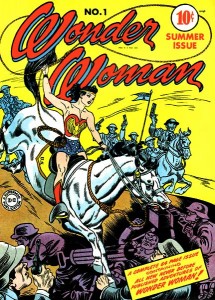
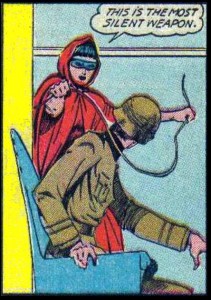
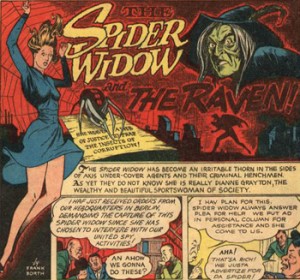
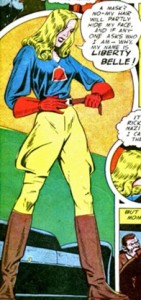
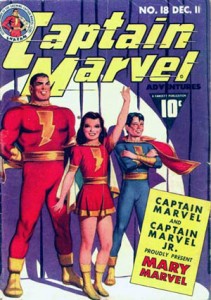
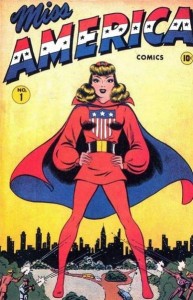
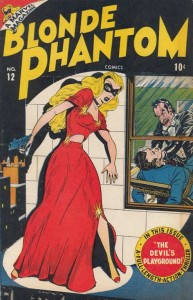
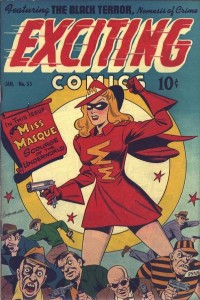
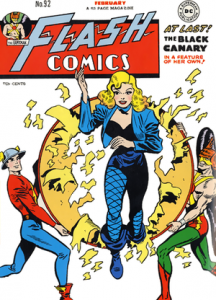
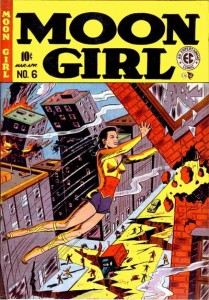
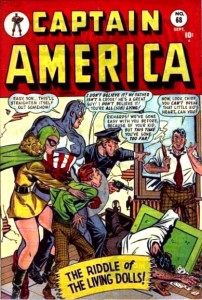
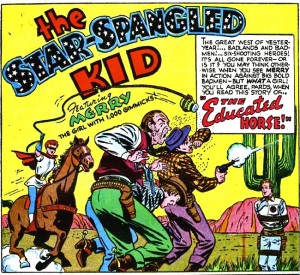
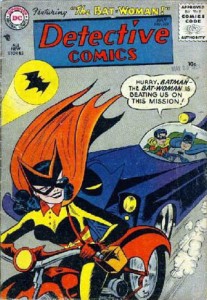
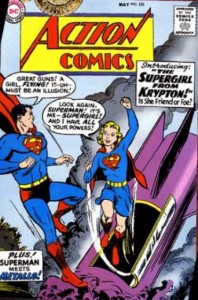

That Red Tornado looks a lot more interesting than the latter-day Red Tornado.
She sure is! Those Sheldon Mayer tales are, along with Plastic Man, the Spirit, Captain Marvel and Wonder Woman among the few 1940s super-hero comics that can still delight us today!
I should note that the list is not exhaustive. If I included every single female sidekick from the 40s then I’d never be finished.
As per Red Tornado – I find it amusing how Marvel and DC keep recycling the same names even when they ditch the original character.
Yes..the Red Tornado was/is pretty funny and enjoyable. If I remember correctly, they include one of the RT stories in the Smithsonian Book of Comic Book Comics along with stalwarts like Carl Barks’ Scrooge, Plastic Man, and C. C. Beck’s Captain Marvel…
I find Black Widow’s premise surprisingly dark for a golden age comic. (She collects souls for Satan). She’s like the 1930s version of Spawn.
Or 1940s, rather.
Occult seemed to be pretty popular in the 40s. There was Black Widow, Lady Satan, the Specter, etc.
Which reminds of the argument I’d heard, that during wartime interest in the occult rises.
——————————–
…There was a sharp rise in occult enthusiasm during WWI, and the seventies occultism coincides perfectly with Vietnam. Perhaps it was a way for many to come to terms with mass casualties, often friends and family. This theory sounds good on the surface, but it doesn’t account for the times of war when there was no widespread interest in the occult. For instance, WWII didn’t bring about anyhttp://lh4.ggpht.com/_LP_YP0I7zZY/Se0NEa0FNnI/AAAAAAAACTw/sin0PTvBWWA/xcagedpassions.jpg such event. So what gives?
———————————-
http://my-retrospace.blogspot.com/2011/08/occult-8.html
Hm! Was the occult interest in the 40s expressed in comics?